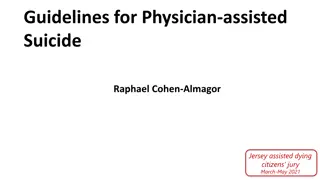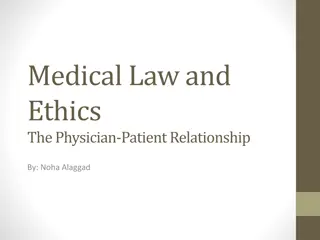Understanding Physician Wellbeing Challenges and Solutions
Exploring the prevalence of burnout among physicians, residents, and medical students, this resource highlights the impact of burnout on patient care and provides insights on achieving wellness in a demanding healthcare environment. It discusses the importance of mindfulness, self-care practices, and cultivating a supportive work-life balance to combat burnout and enhance physician wellbeing.
Download Presentation

Please find below an Image/Link to download the presentation.
The content on the website is provided AS IS for your information and personal use only. It may not be sold, licensed, or shared on other websites without obtaining consent from the author. Download presentation by click this link. If you encounter any issues during the download, it is possible that the publisher has removed the file from their server.
E N D
Presentation Transcript
Physician Wellbeing Resources Provided by WAFP
Table of Contents Burnout in physicians, residents, and medical students Tips for Wellness Depression Suicide Prevention Joy in Practice
Burnout is real 54% of Family Medicine doctors reported burnout at some point in their career. Burnout negatively impacts patient care by leading to charting errors, diminished follow-up, and lack of concern for patient. Mayo Clinic Proceedings 2015 90, 1600-1613DOI: (10.1016/j.mayocp.2015.08.023)
Burnout can be seen at any stage Burnout has been reported in medical students (15%), residents (51%), and practicing physicians (46-54% in family medicine doctors). David A. Rothenberger, Physician Burnout and Well-Being: A Systematic Review and Framework for Action. Diseases of the Colon & Rectum. 60(6):567 576, JUN 2017
What is wellness? Wellness is the state of good health, with balance and poise in life and stressors Many physicians find wellness hard to achieve, due to difficult schedules and demands upon them
Tips for Wellness Meditation Exercise Maintaining hobbies Social Links and Family/Support Relationships Ability to step away from work Developing your Healthy Mindset and clarifying your perspective
Are you helping, fixing or serving? Rachel Remen, MD talks about the difference in a physician s viewpoint as to how they treat a patient: https://drive.google.com/open?id=0B- cjhPGEItnQN0JQdFQ1QzRpV28 Perspective has been shown to influence mindset and can contribute to burnout. The difference between helping (the physician in a position of power), fixing (the patient seen as broken ) and serving (an equal relationship between physician and patient).
How to train yourself to be mindful McConville, et al. 2017 mentions strategies for Mindfulness Training, and presents data on usage in medical students: https://drive.google.com/open?id=0B- cjhPGEItnQaUEwdFgwbXVFR1E Meditation was proposed as a way to lower perceived stress and lower depression and anxiety Lower stress was correlated with increased patient communication scores
Accreditation Council for Graduate Medical Education Well-being Resources http://www.acgme.org /What-We-Do/ Initiatives/Physician- Well-Being These resources link with the American Society for Suicide Prevention and Mayo Clinic
AAFP Physician Wellness http://www.aafp.org/news/inside-
Burnout and Depression - AAFP Clif Knight describing Burnout and Depression: https://drive.google.com/open?id=0B- cjhPGEItnQbExEN2RBOHdEbDA Clif Knight and ways to treat it: https://drive.google.com/open?id=0B- cjhPGEItnQa283MnFRSjZSTFk Family Medicine and Burnout: https://drive.google.com/open?id=0B2l- QFins8ofWFpzOGZRaEtEcjQ
Diana Phillips: Workplace contributions to Burnout https://drive.google.com/open?id=0B- cjhPGEItnQY0JPTVhLeW1yVk0
Physician Depression Rates of Depression and other mood disorders is higher in medical students, residents, and physicians (compared to the general population). Despite working in a healthcare setting, a majority of these physicians suffering from mood disorders will not seek professional help. Robert Bright and Lois Krahn, Depression and Suicide Among Physicians. Current Psychiatry. 2011 April;10(4):16-30
Robert Bright and Lois Krahn, Depression and Suicide Among Physicians. Current Psychiatry. 2011 April;10(4):16-30
Many physicians do not seek help Especially seen in residents and women, seeking help is seen as a weakness . Medical students, residents, and full physicians all cite lack of time as reason for not seeking help, as well as a perceived belief that such help would not be beneficial. Prevention and early treatment considered ideal for depression Robert Bright and Lois Krahn, Depression and Suicide Among Physicians. Current Psychiatry. 2011 April;10(4):16-30
National Suicide Hotline Telephone Call 1-800-273-8255 (also an online chat option) 24 hours a day/7 days a week
Joy of Practice A list of ways to keep the joy of practice alive and avoid burnout
Joy of Practice - Summary (1) proactive planned care, with previsit planning and previsit laboratory tests (2) sharing clinical care among a team, with expanded rooming protocols, standing orders and panel management (3) sharing clerical tasks with collaborative documentation (scribing), nonphysician order entry, and streamlined prescription management; (4) improving communication by verbal messaging and in-box management (5) improving team functioning through co-location, team meetings, and work flow mapping
Joy of Practice - Improvements 1) Proactive planned care, with previsit planning and previsit laboratory tests Burnout has been shown to be reduced when lab tests are performed first thing before the visit, or more than 48 hours before the appointment so that they can be discussed.
Joy of Practice - Improvements 2) Sharing clinical care among a team, with expanded rooming protocols, standing orders and panel management With an increased sharing of care, burnout can be reduced in the physician. Examples include usage of a nurse or medical assistant to help room, ask screening questions, check prescription refills, and examine metabolic panels.
Joy of Practice - Improvements 3) Sharing clerical tasks with collaborative documentation (scribing), nonphysician order entry, and streamlined prescription management Usage of a scribe has been recommended for burnout reduction. The issue of spending many hours on medical charts has been linked to burnout. Any reduction of WAC (work after clinic) is seen as positive Prescription management gives medical assistants or nurses the ability to quickly check on pharmaceutical refills and eliminate forgetting or missed refills.
Joy of Practice - Improvements 4) Improving communication by verbal messaging and in-box management Usage of communication management has been shown to reduce burnout, as physicians have cited burdensome inbox messages as a main cause.
Joy of Practice - Improvements 5) Improving team functioning through co- location, team meetings, and work flow mapping Delegation of responsibility and clarification of duties has been shown to help physicians, as well as improve workflow.
Joy of Practice Problems and Innovations
Additional References David A. Rothenberger, Physician Burnout and Well- Being: A Systematic Review and Framework for Action. Diseases of the Colon & Rectum. 60(6):567 576, JUN 2017 A. Loerbroks, J. Glaser, P. Vu-Eickmann,P. Angerer. Physician burnout, work engagement and the quality of patient care. Occup Med (Lond), 16 May 2017. Robert Bright and Lois Krahn, Depression and Suicide Among Physicians. Current Psychiatry. 2011 April;10(4):16-30























